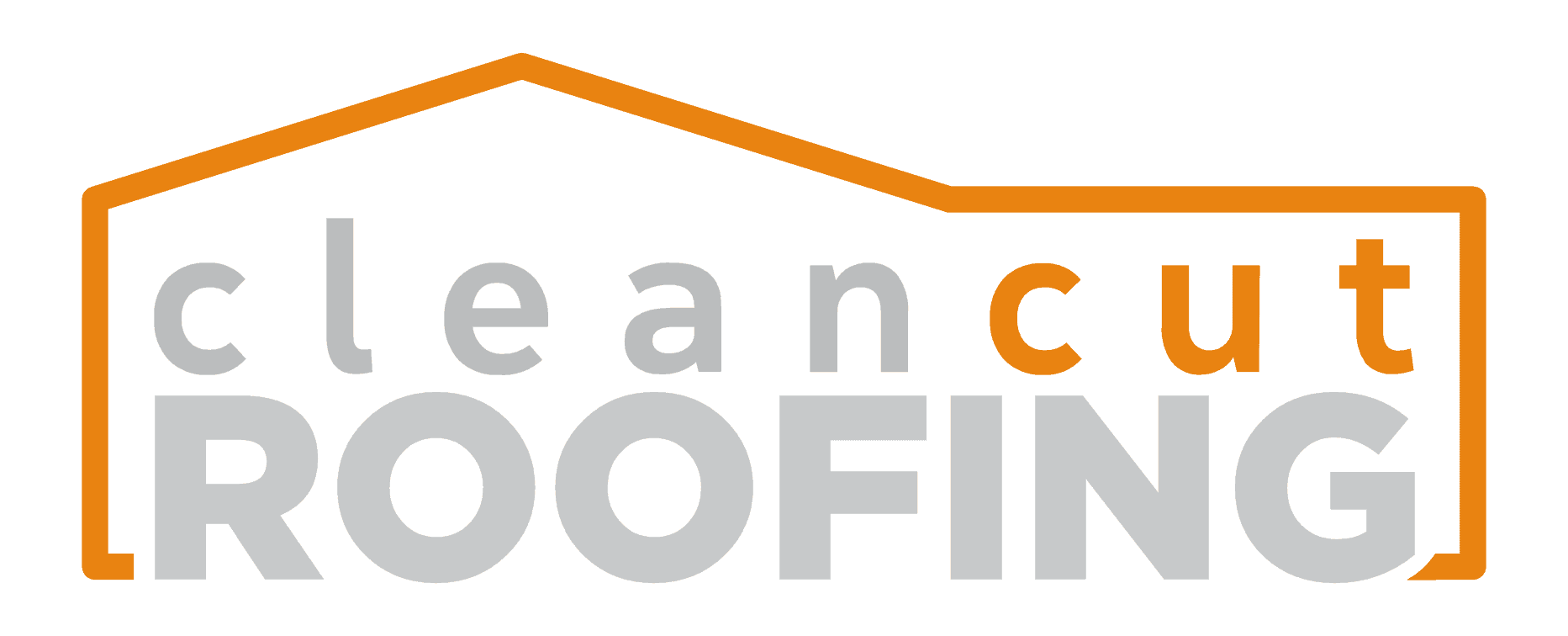Installing a metal roof can be a rewarding DIY project that offers many benefits for your home. However, it can also be a challenging task that requires careful planning, preparation, and execution.
There are different metal roofing materials available, each with its own distinct characteristics, advantages, and disadvantages. Understanding these options can help you make an informed decision.
Ready to install a metal roofing system?
This seven-step guide on how to install a metal roof provides detailed instructions and tips to help you avoid common mistakes and pitfalls. Following this guide will enable you to:
- Save money by installing a metal roof yourself instead of hiring a contractor 💰
- Protect your home from harsh weather conditions with a durable and resistant roofing material 🌧️
- Enhance the appearance and value of your home with a stylish and modern metal roof 🏠
- Reduce your energy bills by reflecting heat and sunlight away from your house 🌞
Ready to get started? Let’s dive into the step-by-step process of installing a metal roof!
A Quick Overview – How to Install a Metal Roofing System

One of the benefits of a metal roof is how customizable it is. You can choose from multiple metal roof colors, styles, and types of metal, which can significantly influence the performance and longevity of the overall metal roof system. When it comes to actually installing a metal roofing system, there are some key steps to stick to:
- Measure Your Roof: Calculate the total square footage and determine the roof’s pitch (angle) from the ridge to the eave.
- Prepare the Roof: Clean the roof, remove debris, and repair any damaged areas. Ensure the roof deck is sturdy enough to support the metal roofing.
- Install Underlayment: Lay down an underlayment to create a smooth, level surface for easier installation and added protection.
- Install Drip Edge: Attach a metal drip edge along the edges of the roof to prevent water from seeping under the panels.
- Add Ridge Cap: Install a ridge cap at the roof’s peak to protect against wind and weather elements.
- Install Flashing: Apply flashing to seal any joints or gaps where metal panels meet, preventing leaks.
- Mount the Metal Panels: Carefully place and align the metal panels, making sure they are evenly spaced. Secure them with fasteners.
Tools and Popular Metal Roofing Materials Required for Metal Roof Installation
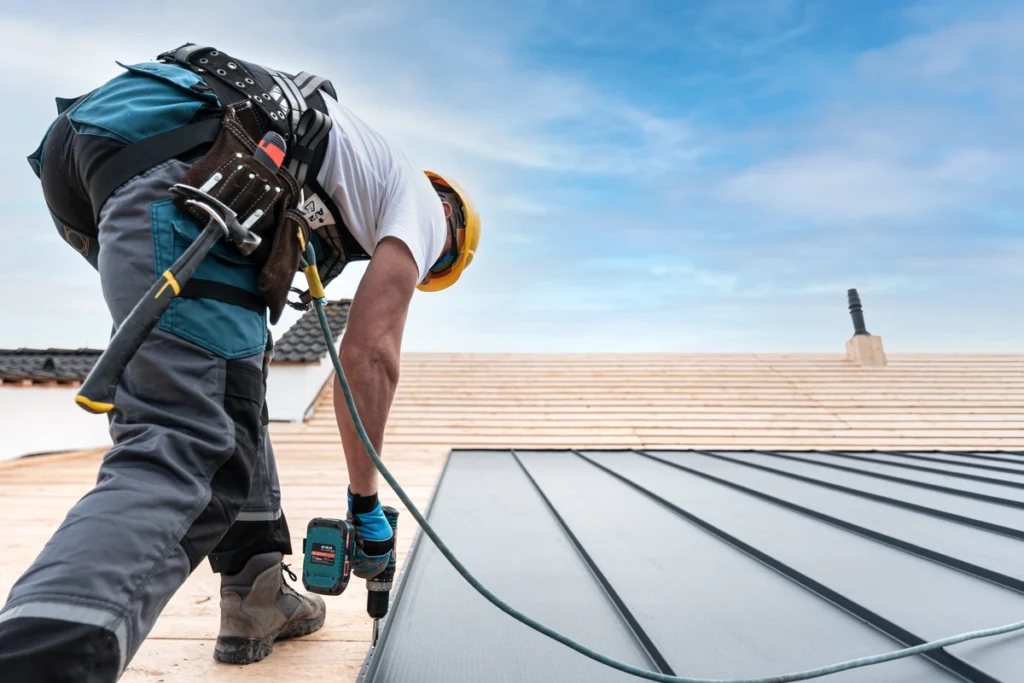
To install a metal roof, you will need the following tools:
- Fastener drivers
- Hemming tool
- Metal snips or shears
- Pitch gauge
- Drill with metal cutting wheel attachment
- Roofing screws
- Butyl tape
- Eave trim and gable trim
- Ice and water shield
- Inside closure strips
- Metal roof panels
- Steel panels
- Circular saw with compatible blade
Galvanized steel is a common material used in metal roofing, known for its durability and cost-effectiveness compared to other options.
Choosing the Right Metal Roofing Material
Choosing the right metal roofing material is crucial for ensuring the durability and longevity of your roof. With various metal roofing materials available, including steel, aluminum, copper, stainless steel, and zinc, it’s essential to consider factors such as climate, budget, and personal preference. Here are some tips to help you choose the right metal roofing material:
- Consider the Climate: If you live in a coastal area, aluminum or stainless steel may be a good choice due to their corrosion resistance. These materials can withstand the salty air and harsh weather conditions without rusting.
- Determine Your Budget: Steel and aluminum are generally more affordable than copper and stainless steel. If you’re working with a tight budget, these materials offer a cost-effective solution without compromising on quality.
- Think About Durability: Copper and stainless steel are known for their longevity, often lasting over 50 years with minimal maintenance. While steel and aluminum may require more upkeep, they still offer excellent durability and can be a great choice for many homeowners.
- Consider the Look: Copper and zinc offer a unique, premium look that can enhance the aesthetic appeal of your home. On the other hand, steel and aluminum are more versatile and can be painted in various colors to match your home’s exterior.
By carefully considering these factors, you can select the best metal roofing material for your home, ensuring a beautiful and long-lasting roof.
Understanding Metal Roofing Fasteners

Metal roofing fasteners are an essential component of a metal roofing system. They secure the metal panels to the roof deck, ensuring a watertight seal and preventing damage from wind and weather. Here are some key things to know about metal roofing fasteners:
- Types of Fasteners: There are two main types of metal roofing fasteners: exposed and concealed. Exposed fasteners are visible on the surface of the metal panels, while concealed fasteners are hidden underneath, providing a cleaner look and additional protection from the elements.
- Materials: Fasteners can be made from various materials, including steel, aluminum, and stainless steel. Each material offers different levels of strength and corrosion resistance, so choose one that complements your metal roofing material.
- Coatings: Fasteners may be coated with a layer of zinc or other materials to provide corrosion resistance. This coating helps protect the fasteners from rust and extends their lifespan.
- Installation: Fasteners should be installed according to the manufacturer’s instructions to ensure a secure and watertight seal. Proper installation is crucial for the overall performance and longevity of your metal roof.
Understanding the different types of fasteners and their proper installation will help you achieve a secure and durable metal roofing system.
Step-By-Step Metal Roof Installation Process
To install a metal roof on your own, you will need to obtain necessary permits, take measurements of the roof area, purchase the correct materials, remove old roofing and make any necessary repairs, install roof underlayment, and then proceed with installing the metal panels and flashing.
Obtain Necessary Permits
Before you get started, obtaining the necessary permits is essential. You’ll need to check with your local jurisdiction about specific regulations and building codes on how to install a metal roof.
The requirement for such permits ensures that every step aligns with safety standards and measures. Neglecting this phase may lead to legal consequences, including fines for noncompliance as per some jurisdictions’ rules.
Once you have detailed plans ready, submit them along with any required documents to your local building department for review.
Take Measurements of the Roof Area
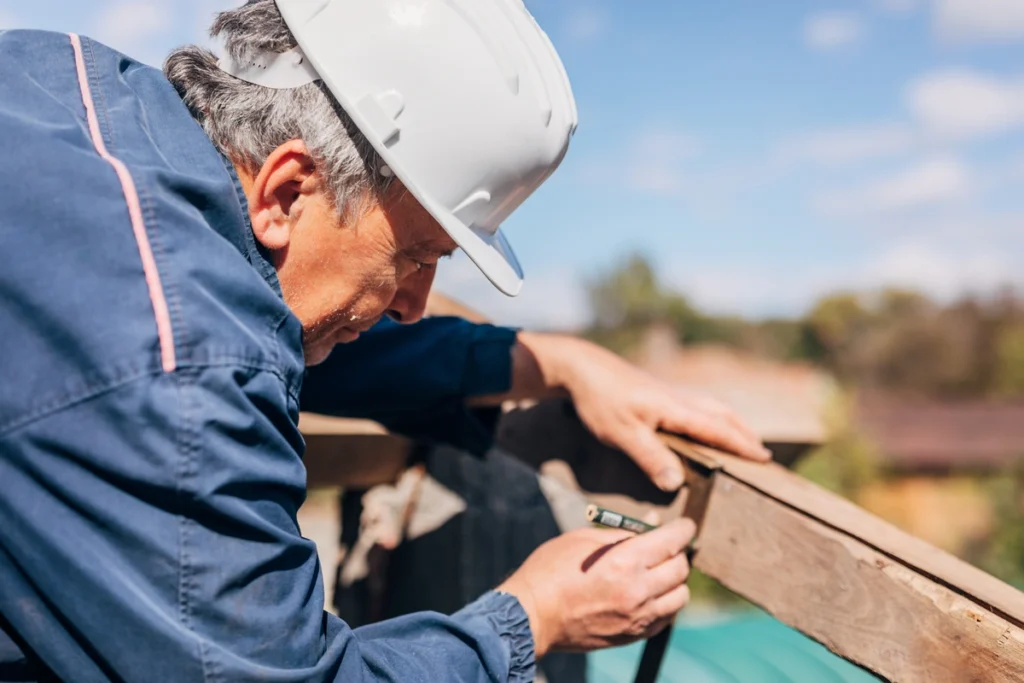
To ensure a proper fit, having the right measurements is key. Start by measuring along the eave, three feet from the corner, or any multiple of three.
Then, at the marked point, measure four feet or the same multiple. Next, snap chalk lines on the panels to mark screw points. These lines should begin six inches from the top of each panel, and additional lines should be snapped every two inches.
Purchase Correct Materials
Having the correct materials is essential for a successful metal roof installation. This includes items such as metal roofing panels, roofing nails, ice and water shield, gable trim, eave trim, self-tapping screws, sidewall flashing, and ridge cap.
By selecting the right materials from the start, you can prevent any delays or issues during the installation process. Take measurements of your roof area beforehand and make a detailed list of everything you need.
Remove Old Roofing and Make Repairs
Before installing your new metal roof, it is crucial to remove the old roofing materials and make any necessary repairs. This step ensures a clean deck for the installation process.
Taking care of these repairs beforehand will ensure a smooth and successful metal roof installation. So, don’t skip this important step—replace, upgrade, or fix any damaged areas before moving forward with your project.
Install Roof Underlayment
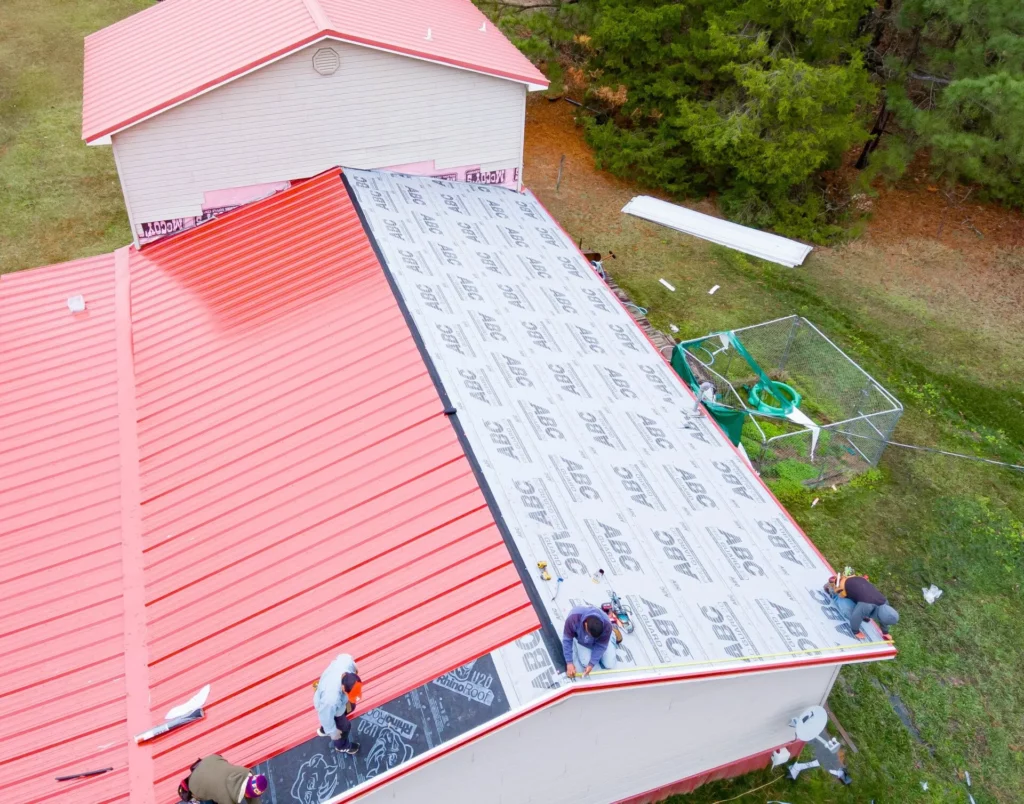
The underlayment acts as a waterproof barrier, protecting your home from water infiltration.
It is typically adhesive-backed and is unrolled across the roof, overlapping the previous layer by six to eight inches, providing an extra layer of protection between the metal roof panels and the roof deck.
Properly attaching the underlayment ensures the integrity and longevity of your metal roof, giving you peace of mind knowing that your home will stay dry and protected for years to come.
Install Metal Panels
To install metal panels on your roof, begin by ordering the panels in the correct dimensions. Once you have the panels, trim the ends and overlap them for a secure installation. Make sure to accurately align the panels using a square reference line.
Then, securely fasten each panel to the roof using screws or clips. Finally, check that all panels are properly installed before moving on to the next step in your metal roof installation process.
Securing the Metal Roof
Securing the metal roof is a critical step in the installation process. Here are some tips to ensure a secure and watertight seal:
- Use the Right Fasteners: Choose fasteners that are compatible with your metal roofing material and designed for your specific roof type. This ensures a strong and secure attachment.
- Follow Manufacturer Instructions: Install fasteners according to the manufacturer’s instructions to ensure a secure and watertight seal. This includes the correct placement and spacing of fasteners.
- Use a Sealant: Apply a sealant around the fasteners to prevent water from entering the roof. This extra layer of protection helps maintain the integrity of your roof.
- Inspect the Roof: Regularly inspect the roof to ensure that the fasteners are secure and the seal is intact. This helps identify any potential issues early and prevents costly repairs down the line.
By following these tips, you can ensure that your metal roof is securely fastened and protected from the elements.
Install Flashing
Flashing is typically placed against the wall at the base of the roof to create a watertight seal and prevent leakage.
To ensure a secure fit, roofing cement should be applied where the flashing will sit. Properly installed flashing helps protect your home from water damage and ensures that your metal roof remains sturdy and durable for years to come.
Adding Finishing Touches to Your Metal Roof
Adding finishing touches to your metal roof can enhance its appearance and performance. Here are some ideas:
- Trim and Flashing: Install trim and flashing around vents, chimneys, and skylights to prevent water from entering the roof. These components not only provide a finished look but also add an extra layer of protection.
- Sealants: Apply sealants around fasteners and seams to prevent water from entering the roof. This helps maintain a watertight seal and extends the life of your roof.
- Coatings: Apply a coating to the metal roof to provide additional protection from the elements. Coatings can also enhance the roof’s appearance and reflectivity, improving energy efficiency.
- Decorative Elements: Add decorative elements, such as metal shingles or corrugated metal panels, to enhance the appearance of your metal roof. These elements can give your roof a unique and stylish look.
By adding these finishing touches, you can improve both the functionality and aesthetics of your metal roof.
Common Mistakes To Avoid During Metal Roof Installation
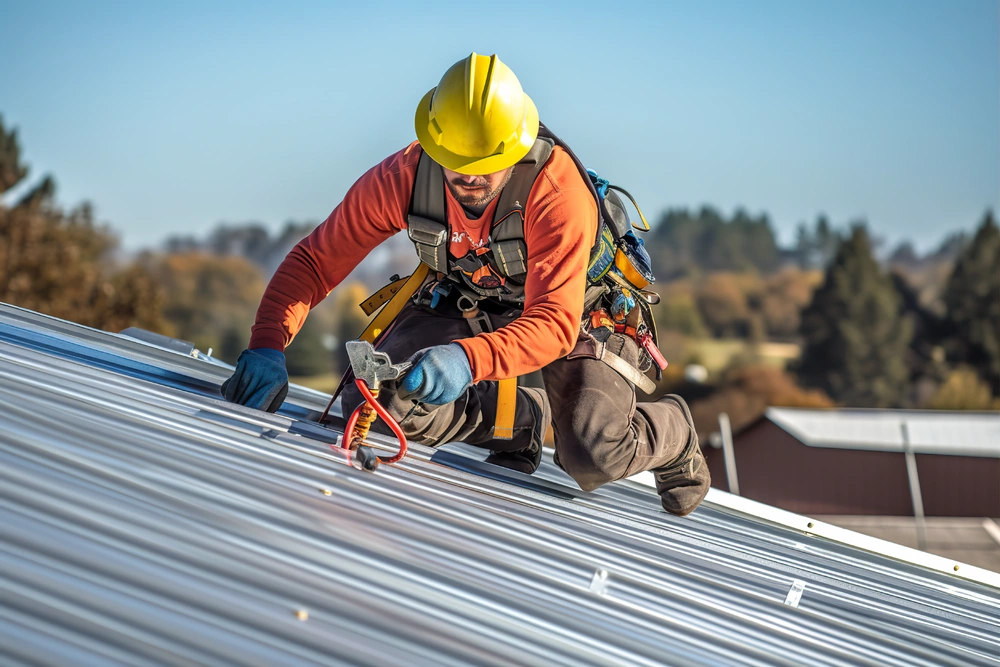
To avoid common mistakes during metal roof installation, you should:
- Use proper flashing to prevent water leaks and damage.
- Use appropriate underlayment to protect your roof deck.
- Hire qualified roofing contractors with metal roofing expertise.
- Plan for expansion and contraction due to temperature changes.
- Repair any damaged roof structures before installing a metal roof.
Benefits of Installing a Metal Roof
A metal roof is a smart choice for your home. Why? Because it offers many benefits, such as:
- Long-lasting: It can last up to 70 years, much longer than other roofs.
- Weather-resistant: It can handle rain, snow, wind, and hail without damage.
- Strong: It can support your home’s structure and resist external forces.
- Lightweight: It is easy to install and does not need extra support.
- Eco-friendly: It is made from recycled materials and can be recycled again.
- Energy-efficient: It reflects heat and sunlight, keeping your home cool and saving you money.
With these benefits in mind, it’s no wonder many homeowners choose a metal roof for their homes.
Final Inspection and Maintenance of Your Metal Roofing
Regular inspection and maintenance are essential to ensure the longevity and performance of your metal roof. Here are some tips:
- Inspect the Roof Regularly: Regularly inspect the roof to ensure that the fasteners are secure, the seal is intact, and there are no signs of damage or wear. Early detection of issues can prevent more significant problems.
- Clean the Roof: Clean the roof regularly to prevent debris from accumulating and causing damage. Removing leaves, branches, and other debris helps maintain the roof’s appearance and functionality.
- Repair Damaged Areas: Repair damaged areas promptly to prevent further damage and ensure the integrity of the roof. Addressing issues quickly can extend the life of your roof.
- Consider a Maintenance Contract: Consider hiring a professional to inspect and maintain your metal roof on a regular basis. A maintenance contract can provide peace of mind and ensure that your roof remains in top condition.
By following these maintenance tips, you can keep your metal roof in excellent condition and enjoy its benefits for many years to come.
Benefits of Installing a Metal Roof
A metal roof is a smart choice for your home. Why? Because it offers many benefits, such as:
- Long-lasting: It can last up to 70 years, much longer than other roofs. Steel roofing, particularly Galvalume and galvanized steel, is known for its durability and cost-effectiveness compared to other metal roofing materials.
- Weather-resistant: It can handle rain, snow, wind, and hail without damage.
- Strong: It can support your home’s structure and resist external forces.
- Lightweight: It is easy to install and does not need extra support.
- Eco-friendly: It is made from recycled materials and can be recycled again.
- Energy-efficient: It reflects heat and sunlight, keeping your home cool and saving you money.
With these benefits in mind, it’s no wonder many homeowners choose a metal roof for their homes.
Ready to Install a Metal Roof on Your Home?
As local roofing experts in Texas, we understand how daunting it can seem to get a new roof – and a metal roofing system comes with its own set of considerations. That’s why we consider it our responsibility to provide home and business owners with top-notch materials and expert installation. If you’re interested in upgrading to metal roofing materials, don’t worry. We’ll take care of you every step of the way.
Contact Clean Cut Roofing today for reliable metal roofing contractors with decades of expertise. Don’t wait any longer and start your metal roof installation today!
